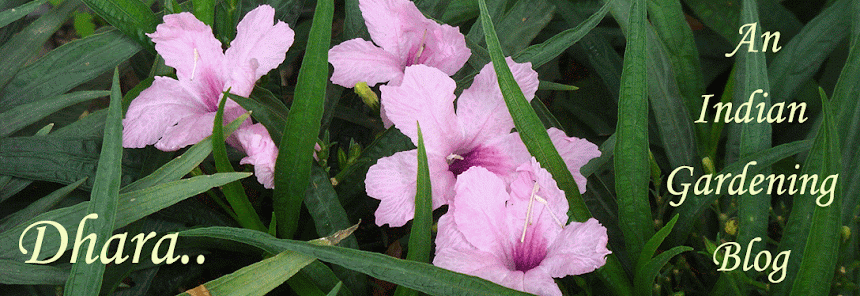I just adore Lady palms. Their dense, dark green, tropical foliage makes them so strikingly attractive!
The Lady palm (Botanic name-Rhapis
Excelsa) is a native of Southern China and is a slow growing palm that can
be grown both outdoors and indoors. It is great as a houseplant because it
cleans toxins such as carbon dioxide, formaldehyde, xylene and ammonia from its
surroundings and is also easy to care for! It is one of the top rated plants for purifying air indoors in a NASA research which studied house plants as a means of providing pure and clean air in space stations!
 |
Each stalk or cane of the Rhapis is thick and covered with dark woven palm fibers (picture above). The tip of each of these stems is the growth point and it will stop growing if you remove the tip. You cannot prune a stem and get new growth from the cut stem as you do with some other plants. So you should only cut a stem when most of the leaves have turned yellow or fallen off and then it should be cut as low as you can go, down to the soil level. This will encourage new shoots to grow from the base of the stem. The plant above has four such canes that I need to cut down to the soil level. It is such a dense plant that I am feeling plain lazy!
The Rhapis Palm propagates itself via underground
rhizome offshoots which is great because they will slowly fill out a pot
beautifully! The Lady palm forms multi-stemmed clumps that can reach
enormous width, spreading as wide as its height or more. I have a couple of
beautiful specimens in pots that are as wide as they are tall-almost 4 feet and I just
love them! The Lady below standing with her pot is taller than me!
A Lady palm should be repotted every
couple of years till it is the size you want it to be or is in too big a pot to
be repotted. Then you can just top dress it. Remove the top 2-3 inches of
soil and replace with fresh soil every couple years. Take care not to harm any
roots that may be near the surface.
Since my pots are too huge and heavy to divide, I plan to cut off some basal
suckers with some roots attached to them and try my luck planting them in a 4
inch pot sizes.
The Rhapis palm prefers filtered
light or partial shade. Outdoors, it will thrive under a canopy of tall trees.
The Lady Palm leaves are dark green when grown in shade to a light green when
grown with more sunlight. Placing it in full sun without protection will cause
unattractive yellow-green leaves and slow growth. The palm below is kept in a
sunny location and you can see the lighter yellow-green color of the leaves as
compared to the beautiful dark green of the one above and the one on top, both
of which are under a canopy of trees. Indoors, Rhapis grow best in bright,
indirect light near a window or skylight but their growth slows considerably inside.
When kept in bright lighting, the Lady Palm
can be kept moderately moist but avoid overwatering them in lower light. The
Lady palm should be thoroughly watered by soaking or drenching the entire root
system as the roots are very deep at the bottom of pot so even though the soil
at top is moist the roots may be dry at the bottom. Do not over water as it is prone to root rot. Do not allow it to wilt as
it will not recover well. I lost a beautiful plant almost ten years old as its
pot had broken and it was unable to retain adequate moisture and I got careless and did not
repot till it was wilting. I was able to save just a single cane in one small pot from a huge dense plant.
Lady Palms are relatively slow-growing plants and
need very little fertilizer. Apply only half the fertiliser required by other
plants. If the leaves are rich green it indicates that fertilizer levels are
okay and you should apply nutrients only when a slight overall yellowish color
is detected.
The nastiest pests to attack them are scales which may hide inside the stalk mesh. A systemic insecticide which gets absorbed in the plant system is the best control.



